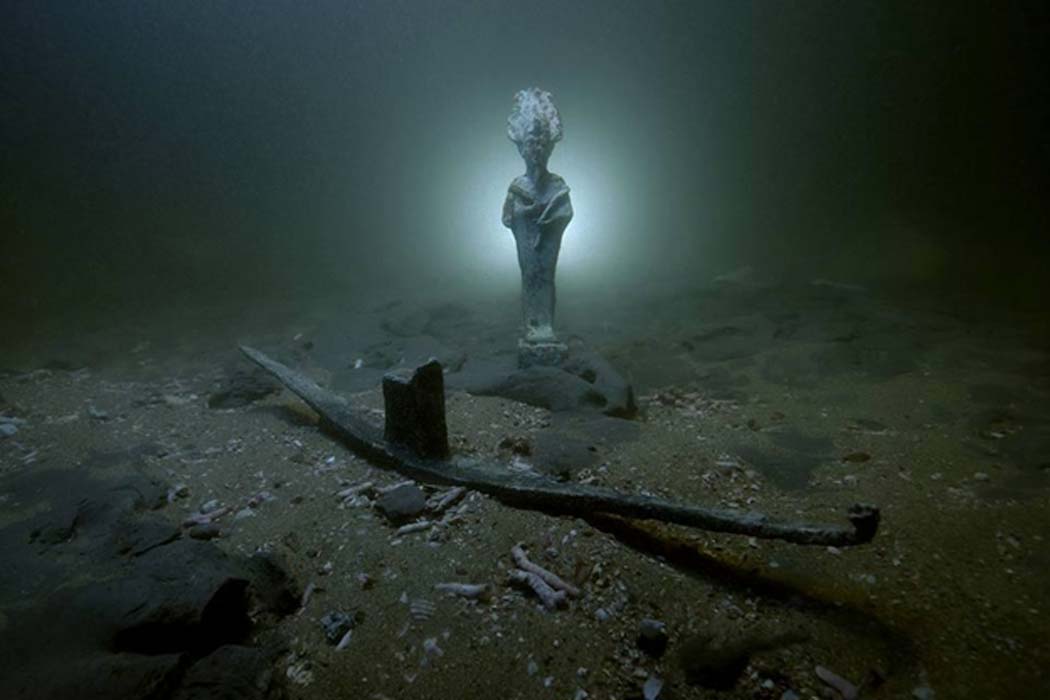Three Roman Shipwrecks with Hoard of Treasures Discovered in Alexandria
A team of archaeologists in Egypt has recently announced the discovery of three underwater shipwrecks full of treasure and other valuable objects that date back to the Roman Era in Abu Qir Bay, Alexandria.
Three Impressive Underwater Shipwrecks Uncovered
The three shipwrecks were unearthed during excavations in the Mediterranean Sea carried out by the European Institute of Underwater Archaeology and the Supreme Council of Antiquities, as Secretary General of the Supreme Council of Antiquities, Mostafa al-Waziry, announced. According to Egypt Independent, Waziry added in a press statement that the archaeological mission also discovered a Roman head carved in crystal that could possibly belong to the commander of the Roman armies of “Antonio”, in addition to three gold coins dating back to the Emperor “Octavius”. The discoveries took place at the coast of the northern city of Alexandria, specifically in its Abu Qir Bay.

The carved crystal head that was found at the site of the wrecks. (Image: Egyptian Ministry of Antiquities)
- Ancient Wonder of the World: Egypt Approves Plan to Rebuild Pharos of Alexandria
- The great Pharos of Alexandria
- What Treasures Were Lost in the Destruction of the Great Musaeum of Alexandria?

Pharos of Alexandria: Idealized representation of the Bay of Alexandria. (Public Domain )
Alexandria’s Vast Underwater Treasures
Alexandria, located on the Mediterranean coast in Egypt, has seen many changes in its 2,300 year history. Founded by Greek general Alexander the Great in 331 BC, at its height it rivalled Rome in its wealth and size, and was the seat for the Ptolemaic dynasty. However, through history not all agreed on how to regard the Hellenistic city with a royal Egyptian past. An underwater temple discovered by marine divers off the eastern coast shed light on the pharaonic nature of ancient Alexandria.
As previously reported in Ancient Origins, Ptolemaic Alexandria has been regarded, in academic circles, not as part of Egypt, but as a separate Greek polis, or city-state, by the borders of Egypt. However, in 1998, an important archaeological discovery was made in Alexandria which confirmed the pharaonic nature of Egyptian Alexandria. Under the heading “Sea gives up Cleopatra’s treasures”, the London Sunday Times reported the story on 25 October 1998: “Secrets of Cleopatra’s fabled royal palace, in which she wooed Julius Caesar, have been retrieved from beneath the waves of the Mediterranean sea, where they have lain for more than 1,600 years.” This remarkable discovery came about after the European Institute of Underwater Archaeology (IEASM) had been given permission in the 1990s to work in the east part of the Eastern Harbor, where the Ptolemaic royal quarter was situated.
After some years of mapping and searching the area, Frank Goddio, the French leader of the underwater team of archaeologists, was able to announce before the end of 1998 that he had discovered the royal palace of Cleopatra (51-30 BC), the last of the Ptolemaic rulers.

Ancient Egyptian statues found beneath the waves of Alexandria's Eastern Harbor. (Credit: The Hilti Foundation)
Goddio’s divers found marble floors on the seabed which he believes established for the first time the precise location of Cleopatra’s palace. They also found lumps of red granite and broken columns on the submerged island of Antirhodos, which provided Goddio with further evidence of the site of the royal quarters. Remains of Cleopatra’s royal palace were retrieved from beneath the waters of the Mediterranean Sea where they had disappeared for 17 centuries. The divers reported seeing columns and capitals in disorder, kilns and basins - some of which were described as the so-called ‘Baths of Cleopatra’; great blocks of dressed limestone, statues of Egyptian divinities, and even walls.
- Egyptian Alexandria - Ancient underwater finds revealed the Pharaonic roots of the Ptolemaic City
- The destruction of the Great Library of Alexandria
- Ancient Sunken Cities and Artifacts to be revealed with Ambitious Underwater Museum in Egypt

One of the Roman coins found in the shipwrecks (Image: Egyptian Ministry of Antiquities)
Fourth Shipwreck May be Unearthed Soon
Almost two decades later, Alexandria keeps delivering extremely significant archaeological treasures and will most likely continue to do so for many years to come. Dr. Osama Alnahas, Head of the Central Department of the Underwater Antiquities, stated as Egypt Independent reported, that the initial excavations indicate that a fourth shipwreck remains could be unearthed very soon. According to Dr. Alnahas the team has unearthed large wooden planks, as well as pieces of pottery vessels that most likely represent the ships’ hull and cargo.
Dr. Ayman Ashmawy, Head of the Ancient Egyptian Antiquities Sector, informed the press that the archaeological team launched its excavation works last September. Ultimately, Egypt Independent reports that underwater exploration by both projects have included a research of the soil in both the eastern port and the Abu Qir Bay, underwater excavations at the Heraklion sunken city in Abu Qir Bay which includes the discovery of a votive bark of the god Osiris, as well as the completion of the conservation and documentation works.
Top image: Sunken ships, statues and treasure have been found under water at in bay near Alexandria. (Image: Egyptian Ministry of Antiquities)

















